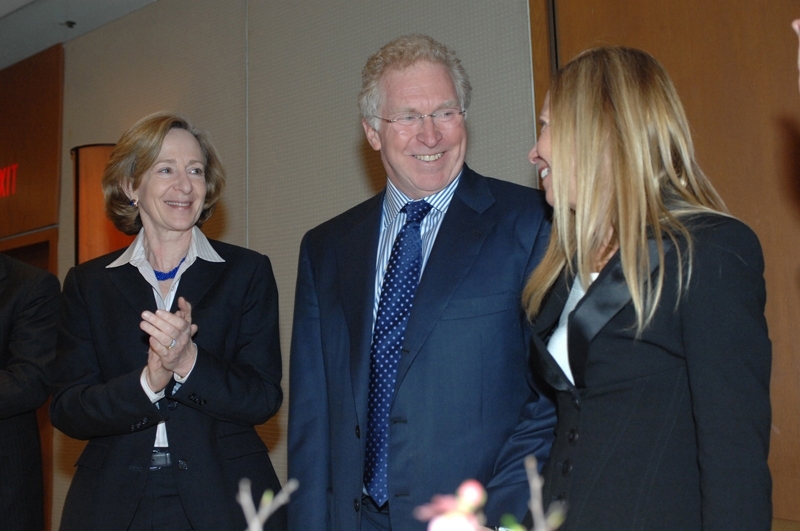MIT is joining Massachusetts General Hospital and Harvard in a bold new initiative to develop an AIDS vaccine, a challenge perfectly suited to the Institute and its world-leading expertise in engineering, computational sciences, molecular biology, clinical research and interdisciplinary research.
Founded through a 10-year, $100 million grant from the Phillip T. and Susan M. Ragon Institute Foundation, the Ragon Institute will bring together scientists and engineers from MIT, MGH and Harvard in a collaborative environment designed to support basic scientific research that can be applied for clinical use.
Phillip (Terry) Ragon is a 1971 graduate of MIT and founder of Cambridge-based InterSystems Corporation.
The new institute, announced Wednesday, Feb. 4, will play to MIT's strengths in interdisciplinary research, in particular the combination of engineering and life sciences, said Subra Suresh, dean of the School of Engineering and Ford Professor of Engineering.
"The study of human diseases has been a rapidly growing focus of research in the MIT School of Engineering in recent years," Suresh said. "The importance of the engineering disciplines in the study and eventual cure of human diseases is being increasingly emphasized by the biological and medical communities. We are delighted with the opportunities this very generous gift presents to further expand the role of MIT engineering in the study of human diseases, and we are excited about opportunities for even greater collaborations in this area with the School of Science, and between MIT, Harvard and the Massachusetts General Hospital."
'A SHINING EXAMPLE'
Since HIV was identified as the cause of AIDS more than 25 years ago, more than 25 million people have died. While some effective treatments exist, the search for a vaccine has been unsuccessful so far.
"I am delighted that our alumnus, Terry Ragon, has encouraged the collaboration between MGH, Harvard and MIT scientists and engineers in the fight against AIDS," said Marc Kastner, dean of MIT's School of Science. "A major revolution in the next decade will come from the convergence of biology and the physical sciences and engineering, and the Ragon Institute will be a shining example of this revolution."
The steering committee for the Ragon Institute includes faculty members from each of the collaborating institutions, with two each from MIT, Harvard and MGH. It will be headed by Bruce Walker from MGH, a leader in the study of the human adaptive immune response to HIV infection.
The new institute will continue the hallowed MIT tradition of contributing its engineering and science expertise to help solve global problems, said Arup Chakraborty, the Robert T. Haslam Professor of Chemical Engineering, Chemistry and Biological Engineering and a member of the faculty steering committee planning for the new institute.
"What MIT brings to the table is new technology, as well as computational models that offer new approaches to thinking about basic immunology in the context of human responses to infection," said Chakraborty, who uses computational methods to study the immune response.
Darrell Irvine, the Eugene Bell Associate Professor of Materials Science and Engineering and Biological Engineering, is the second MIT faculty member of the steering committee. His laboratory develops methods to image immune cell functions and also develops materials for vaccine delivery.
"The institute will act as a bridge to allow faculty from engineering and the physical sciences to bring new technologies of relevance to HIV into the field, and facilitate collaborations with some of the leaders in the HIV vaccine effort," Irvine said.
TARGETING THE IMMUNE RESPONSE
Key MIT faculty involved in the Ragon Institute will also include Jianzhu Chen, professor of biology; Hidde Ploegh, professor of biology and member of the Whitehead Institute; and Christopher Love, assistant professor of chemical engineering.
Other faculty will be drawn from a range of fields, including chemical engineering, chemistry and biology. "All of us who are involved in this are very excited about the opportunity to focus on this particular problem," Love said.
Love and others will focus on studying the immune responses of rare individuals who are infected with HIV but do not progress to AIDS. Figuring out how to induce that kind of immunological control of the virus could help researchers develop a vaccine for people with different genotypes.
Love's lab has developed new assays that can monitor the immune response of single cells, allowing them to pinpoint precisely how the responses differ.
"If you understand what characteristics in the response are correlated with effective protection, then from an engineer's perspective you can think about designing a vaccine that would provoke the same kind of response," Love said.
In another line of attack, researchers will study the behavior of a special subset of immune cells, known as CD8 T cells, responsible for remembering what pathogens the body has encountered. Vaccines that resemble the HIV virus could prime the immune system to "remember" the virus and help the body mount a more successful response if HIV is encountered, Chen said.
"By better understanding the basic principles of the immunological response, especially CD8 cells, we can more rationally develop vaccines against HIV," he said.
A version of this article appeared in MIT Tech Talk on February 4, 2009 (download PDF).








